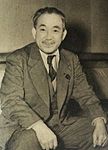
Politics of Japan are conducted in a framework of a dominant-party bicameral parliamentary constitutional monarchy, in which the Emperor is the head of state and the Prime Minister is the head of government and the head of the Cabinet, which directs the executive branch.

The House of Representatives is the lower house of the National Diet of Japan. The House of Councillors is the upper house. The composition of the House is established by Article 41 and Article 42 of the Constitution of Japan. The House of Representatives has 465 members, elected for a four-year term. Of these, 176 members are elected from 11 multi-member constituencies by a party-list system of proportional representation, and 289 are elected from single-member constituencies.

The Democratic Party of Japan was a centrist to centre-left liberal or social-liberal political party in Japan from 1998 to 2016.

The Social Democratic Party is a political party in Japan that was established in 1996. Since its reformation and name change in 1996, it has advocated pacifism and defined itself as a social-democratic party. It was previously known as the Japan Socialist Party.

Ichirō Ozawa is a Japanese politician and has been a member of the House of Representatives since 1969, representing the Iwate 3rd district. He is often dubbed the "Shadow Shōgun" due to his back-room influence.

The Japanese political process has three types of elections.

General elections were held in Japan on 20 October 1996. A coalition of the Liberal Democratic Party, New Party Sakigake and the Social Democratic Party, led by incumbent Prime Minister Ryutaro Hashimoto of the LDP won the most seats.

House of Councillors elections were held in Japan on 23 July 1989.

House of Councillors elections were held in Japan on 1 July 1962, electing half the seats in the House. The Liberal Democratic Party won the most seats. This was the first Japanese national election to feature the Kōmeitō as a candidate, as it had formed earlier in the same year.

House of Councillors elections were held in Japan on 29 July 2001. They were the first national elections since Junichiro Koizumi became Prime Minister after Yoshiro Mori resigned in April 2001. The Liberal Democratic Party (LDP) and its election allies, were the major winner, provided Koizumi a strong mandates to move forward with his reform policies. The ruling coalition performed well, and regain their majority in the House of Councillors.

House of Councillors elections were held in Japan on 22 June 1980. On 16 May the Japan Socialist Party (JSP) brought no-confidence motion before the Diet relating to corruption issues, proposing more defense spending and rises in public utility charges as reasons for the House of Representatives to withdraw its backing from the government. Unexpectedly, 69 Liberal Democratic Party (LDP) members of the Diet from the Fukuda Takeo, Miki Takeo and Hidenao Nakagawa factions abstained from voting on the motion. The government was defeated by 56 votes in total of 243 and resigned. For the first time elections for both the House of Councillors and the House of Representatives were elected at the same time. In the elections of both the houses the LDP gained a majority.

House of Councillors elections were held in Japan on 12 July 1998.

House of Councillors elections were held in Japan in 1995.

House of Councillors elections were held in Japan in 1977. Only half of the House of Councillors was up for election.

House of Councillors elections were held in Japan on July 11, 2010. In the previous elections in 2007 the Liberal Democratic Party (LDP) had lost its majority to the Democratic Party (DPJ), which managed to gain the largest margin since its formation in 1996. The House of Councillors is elected by halves to six-year terms. The seats up for election in 2010 were last contested in the 2004 election.
The Hatomander was an electoral reform proposed in the 1950s by Japanese prime minister Ichirō Hatoyama and his third cabinet. His plan was to replace the SNTV multi-member constituencies for the House of Representatives entirely with First-past-the-post single-member districts. The change would have made it easier for Hatoyama's Liberal Democratic Party (LDP) to gain a two-thirds majority on its own, enabling him to pursue his plan to change the Japanese Constitution, particularly Article 9. The plan faced strong opposition led by the Japanese Socialist Party (JSP) that accused Hatoyama of wanting to "hatomander" the electoral districts to his needs. An electoral reform bill was presented to the Diet in March 1956, passed the House of Representatives in May 1956, but was not voted on in the House of Councillors in a still ongoing debate at the end of the Diet session. The LDP failed to win a majority in the House of Councillors election in July, and the plan was shelved.

House of Councillors elections were held in Japan on 7 July 1974, electing half the seats in the House. The Liberal Democratic Party won the most seats.

General elections were held in Japan on 22 October 2017. Voting took place in all Representatives constituencies of Japan – 289 single-member districts and eleven proportional blocks – in order to appoint all 465 members of the House of Representatives, the lower house of the then 707-member bicameral National Diet of Japan. Incumbent Prime Minister Shinzō Abe's governing coalition of the Liberal Democratic Party (LDP) and the Komeito party retained their seats in signs of what was perceived as weak opposition. The PM won his fourth term in office and held on to the two-thirds supermajority in order to implement policies on revising the war-renouncing Article 9 of the Japanese Constitution.

House of Councillors elections were held in Japan on 21 July 2019 to elect 124 of the 245 members of the House of Councillors, the upper house of the then 710-member bicameral National Diet, for a term of six years.














